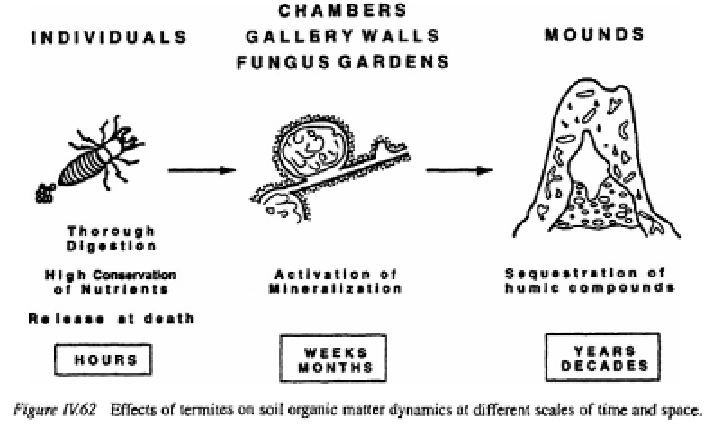Agriculture Reference
In-Depth Information
Termites strongly influence soil organic matter dynamics. They sequester organic
matter and biological nutrient elements for considerable periods in their nests, mounds
and in the walls of their galleries and other structures. The breakdown and erosion of
above-ground structures through the agencies of organisms, rainfall and perhaps wind
constantly return their contained nutrients to the soil surface. Also, roots of surrounding
plants frequently abstract nutrients from the often-concentrated stores held in the bases
of termite mounds and within decomposing organic materials in back-filled subterranean
voids (Figure IV.62).
Where nutrient concentrations in the termite-derived organic matter are high, the
sequestration of organic matter within termite mounds leads to a nutrient patchiness in
the landscape which helps to maintain ecological diversity. In many infertile savanna
environments, the only places where plants requiring a high nutrient status may grow
satisfactorily is on and adjacent to termitaria. The underground gallery systems created
by termites improve gas exchange with the atmosphere and facilitate water infiltration
and movement through the soil. Termites may also help to restart nutrient cycling
processes in degraded ecosystems through mechanisms of nutrient concentration and
organic matter breakdown, and their considerable effects on soil physical processes.
Because their diversities and populations are highest in the inter- and sub-tropics, it is
there that termites have their greatest impact. As discussed below, the effects of termites
on soil processes are significant at spatial scales ranging from the landscape to the catena
to the micro-aggregate and even to the clay mineral level. In addition, their effects are
expressed in soils at time scales ranging from the geological, to years, to a few months.
Termites have also played significant roles in the formation and development of certain
palaeosols (see, for example, Tardy and Roquin, 1992) whose soils may therefore be
considered as forming biomantles.

